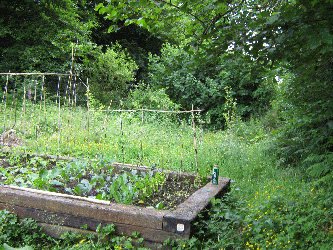
The house consists mainly of granite blocks. It was built sometime between 1809 (it is not shown on the Ordnance Survey map of that date) and 1845 (when the Ramsley coppermine, which it formed part of, is known to have been in action). The mine is almost certainly a decade or so older than 1845, but in the early years no records were kept.

|
The first picture shows the main house, photographed from the bog pond, with Ailie's bridge over the Ramsley stream in the foreground. Behind the house are the spoils from the copper mine. The copper-bearing beds were split in two by the Sticklepath fault, which carried the other half to the site of the Belstone mine two miles north-west. At 14.45 on 23 June 2011 there was movement on the fault line at Richter scale 2.7 with epicentre near Bovey Tracey; we heard it but felt nothing.

|
The second looks across the main property from north to south. The Ramsley stream is immediately beyond the mown lawn and behind the trees on the right, which still carry timber broken off during the heavy snow of early 2009. The trees continue up the lower slopes of Cosdon Beacon, one of the northernmost tors of Dartmoor. Behind us is the village of South Zeal. Until around 1960 there was a building on the left side of the picture which supported a massive millwheel for the Ramsley mine. The wheel was driven by a 13th century leat taken from the Blackaton stream a couple of miles away. We plan to build a maze in the long grass, preferably not one solvable by the hand-on-wall rule.

|
The third shows the recently-planted orchard behind one of the vegetable beds. Beyond the trees is open moor. On the border bank Valentin Shehtman discovered quite a large gooseberry bush which we had completely missed.

|
The fourth looks upstream along the Ramsley stream. There are regularly dippers here. Probably there weren't in the 1950s, when (according to the long-term inhabitants of South Zeal) the stream served as the toilet for the house. On our property we also have blackbirds, blackcaps, blue tits, chaffinches, chiffchaffs, coal tits, crows, dunnocks, great tits, grey wagtails, jays, magpies, mistle thrushes, nuthatches, owls, robins, willow warblers, wood pigeons and wrens. Buzzards frequently fly overhead. Cuckoos are audible from the moor, and we sometimes find cuckoo chicks. Other visitors are jackdaws, long-tailed tits, marsh tits, pheasants, ravens, swallows, tree creepers and woodpeckers. Herons do visit the bog pond though they aren't resident. We have yet to see or hear a sparrow or a starling here. The stream is believed to follow the Sticklepath fault up to this point, though immediately behind us it is captured by the valley of the Taw.

|
The fifth is the cat Plato. He is not our cat, though we have cordial relations with him. He is semi-wild and he was already installed as the guardian of the Ramsley valley when we arrived. Update: Sadly Plato died on 29 November 2010, of a heart problem and complications. He is buried by the path to the orchard, where he used to play chicken with the wheels of our wheelbarrows.
|
Author : Wilfrid Hodges Last updated 24 June 2011 |